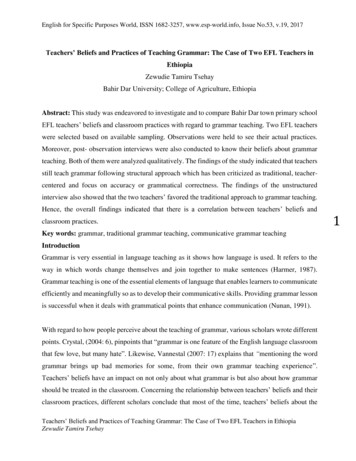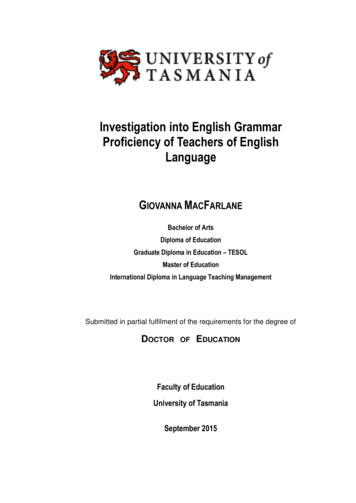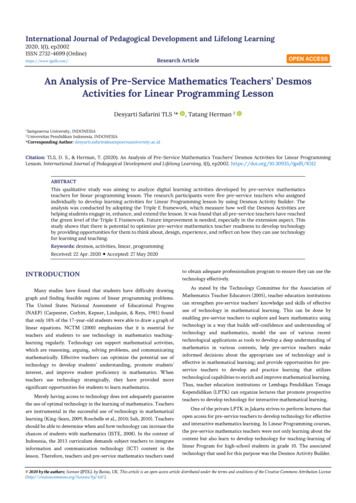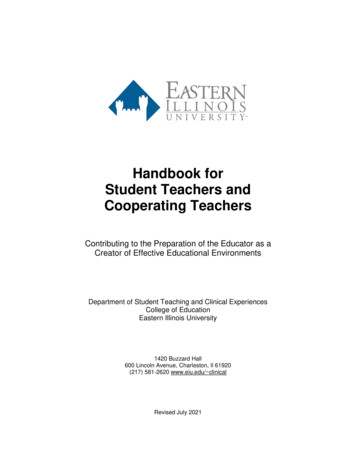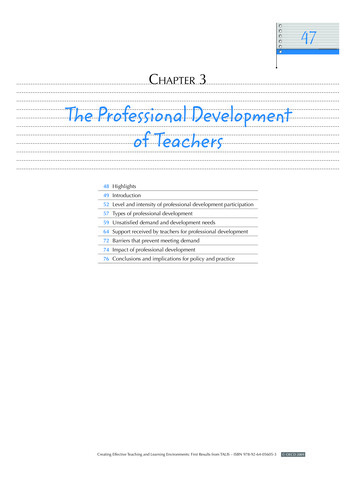
Transcription
47CHAPTER 3The Professional Developmentof Teachers48 Highlights49 Introduction52 Level and intensity of professional development participation57 Types of professional development59 Unsatisfied demand and development needs64 Support received by teachers for professional development72 Barriers that prevent meeting demand74 Impact of professional development76 Conclusions and implications for policy and practiceCreating Effective Teaching and Learning Environments: First Results from TALIS – ISBN 978-92-64-05605-3 OECD 2009
48CHAPTER 3 THE PROFESSIONAL DEVELOPMENT OF TEACHERSHighlights In the participating countries, an average of 89% of teachers in lower secondaryeducation engaged in professional development. The 11% who did not are asource of concern. Around one in four teachers did not participate in professionaldevelopment in Denmark, the Slovak Republic and Turkey. On average in TALIS countries, teachers participated in professional developmentfor just under one day per month. A significant proportion of teachers think that professional development doesnot meet their needs: over half reported wanting more than they received duringthe previous 18 months. The aspect of their work for which teachers most frequently say they requireprofessional development is “Teaching special learning needs students”, followedby “ICT teaching skills” and “Student discipline and behaviour”. Teachers who paid the full cost of professional development took part in morethan those who received it free or at partial cost. This is partly because the moretime-intensive development activities were more likely to be paid for by teachersthemselves. Even when development is paid for by teachers, their demand is not satisfied:those who paid towards the cost were more likely to say they wanted more. The main reason for unfulfilled demand (according to teachers) is the conflictwith their work schedule, but lack of suitable development opportunities is alsoa significant factor. The types of development that teachers regard as the most effective have, onaverage, lower rates of participation. However, those who do participate inthese activities also devote more time to them than those participating in otheractivities, even though they are more likely to have to pay for them. This suggests a need not just for better support for teachers to participate inprofessional development, but for policy makers and school leaders to ensure thatthe development opportunities available are effective and meet teachers’ needs. OECD 2009Creating Effective Teaching and Learning Environments: First Results from TALIS – ISBN 978-92-64-05605-3
49THE PROFESSIONAL DEVELOPMENT OF TEACHERS CHAPTER 3INTRODUCTIONIn many countries, the role and functioning of schools are changing and so is what is expected of teachers.Teachers are asked to teach in increasingly multicultural classrooms; to place greater emphasis on integratingstudents with special learning needs in their classrooms; to make more effective use of information andcommunication technologies for teaching; to engage more in planning within evaluative and accountabilityframeworks; and to do more to involve parents in schools.No matter how good pre-service training for teachers is, it cannot be expected to prepare teachers for all thechallenges they will face throughout their careers. Education systems therefore seek to provide teachers withopportunities for in-service professional development in order to maintain a high standard of teaching and toretain a high-quality teacher workforce. As OECD’s comparative review on teachers noted (OECD, 2005):Effective professional development is on-going, includes training, practice and feedback, and providesadequate time and follow-up support. Successful programmes involve teachers in learning activities thatare similar to ones they will use with their students, and encourage the development of teachers’ learningcommunities. There is growing interest in developing schools as learning organisations, and in ways forteachers to share their expertise and experience more systematically.The development of teachers beyond their initial training can serve a number of objectives (OECD, 1998),including: to update individuals’ knowledge of a subject in light of recent advances in the area; to update individuals’ skills, attitudes and approaches in light of the development of new teaching techniquesand objectives, new circumstances and new educational research; to enable individuals to apply changes made to curricula or other aspects of teaching practice; to enable schools to develop and apply new strategies concerning the curriculum and other aspects ofteaching practice; to exchange information and expertise among teachers and others, e.g. academics, industrialists; and to help weaker teachers become more effective.To examine these issues, TALIS adopts a broad definition of professional development among teachers:“Professional development is defined as activities that develop an individual’s skills, knowledge, expertiseand other characteristics as a teacher.”The definition recognises that development can be provided in many ways, ranging from the formal to theinformal. It can be made available through external expertise in the form of courses, workshops or formalqualification programmes, through collaboration between schools or teachers across schools (e.g. observationalvisits to other schools or teacher networks) or within the schools in which teachers work. In this last case,development can be provided through coaching/mentoring, collaborative planning and teaching, and thesharing of good practices.TALIS asked teachers about their professional development activities during the 18 months prior to the survey(Box 3.1). This period of time was chosen in order to cover activities over almost two school years in orderto give a more representative picture and lessen possible distortions due to unusually busy or lean periods ofdevelopment and to ensure a manageable period for teachers’ recall.Creating Effective Teaching and Learning Environments: First Results from TALIS – ISBN 978-92-64-05605-3 OECD 2009
50CHAPTER 3 THE PROFESSIONAL DEVELOPMENT OF TEACHERSBox 3.1 Types of professional developmentTALIS asked lower secondary teachers about the professional development they had participated induring the 18 months prior to the survey. Teachers were first asked to indicate whether or not they hadparticipated in each of the following activities: courses/workshops (e.g. on subject matter or methods and/or other education-related topics); education conferences or seminars (at which teachers and/or researchers present their research resultsand discuss education problems); qualification programme (e.g. a degree programme); observation visits to other schools; participation in a network of teachers formed specifically for the professional development ofteachers; individual or collaborative research on a topic of professional interest; and mentoring and/or peer observation and coaching, as part of a formal school arrangement.Teachers were able to indicate participation in multiple activities.TALIS then asked teachers how many days of professional development they had attended in the 18 monthsprior to the survey and how many of these days were compulsory. Table 3.1 gives this information.As TALIS was interested in professional development activities beyond the more structured types listedabove, teachers were also asked whether or not they had participated in the following less formalprofessional development activities: reading professional literature (e.g. journals, evidence-based papers, thesis papers); and engaging in informal dialogue with peers on how to improve teaching.Analysis of participation in these activities and their impact is included in Tables 3.2 and 3.8.TALIS asked teachers about their professional development activities, their impact, the support they receivedfor undertaking them, the extent to which they wanted more than they had engaged in and the barriers they felthad prevented them from doing so, and the areas of their work they found most in need of further development.Therefore, almost all of the results in this chapter are based on teachers’ reports. The exception is the discussionof induction and mentoring policies in schools, which reports school principals’ responses regarding theexistence of such policies in their schools.In interpreting the results, it is important to bear in mind the self-reporting nature of the survey responses. Forexample, teachers’ reports about the impact of their development activities represent their perceptions; they arenot part of an independent evaluation of the effectiveness of these activities. Nevertheless, teachers’ perceptionsare important and can be expected to influence their behaviour. Also teachers’ views about their developmentneeds are to be distinguished from an external assessment of these needs. Chapter 5 will examine the relationbetween teachers’ reports of their development needs and the policies and practices that are in place to assessand appraise teachers’ work. OECD 2009Creating Effective Teaching and Learning Environments: First Results from TALIS – ISBN 978-92-64-05605-3
51THE PROFESSIONAL DEVELOPMENT OF TEACHERS CHAPTER 3Chapter outlineThis chapter seeks to answer the following three questions: How much does the amount and profile of teachers’ professional development vary within and amongcountries? How well are teachers’ professional development needs being met? How can unsatisfied demand for professional development be best addressed?The chapter first examines teachers’ participation in professional development and compares the intensityof that participation in terms of number of days. The focus in this section is on more structured activities,such as attendance at courses and workshops, conferences and seminars, etc. More informal activities, suchas engagement in informal discussions to improve teaching and reading professional literature, which arenot readily measurable in terms of numbers of days, are excluded from these measures (See Box 3.1). Thesection then looks at the extent to which intensity of participation in professional development differs with thecharacteristics of the teacher or the schools in which they work and so provides some insight into the distributionof development opportunities. It does not seek to be exhaustive; it focuses on the characteristics that are mostoften of interest to policy makers. This section thus sheds light on how the policy choices countries make interms of providing professional development opportunities are reflected in a comparison of participation ratesand intensity rates.The volume (or intensity) of professional development can be influenced by the types of development activitiesthat teachers engage in. The chapter therefore goes on to profile all types of activities listed in Box 3.1, contrastingformal and less formal development activities, and shows how teachers combine different forms of professionaldevelopment.In the light of these participation patterns, the chapter then investigates how well teachers’ professionaldevelopment needs are being met. It compares the extent of unsatisfied demand within and between countriesand identifies the areas of teachers’ work which teachers regard as those in which they have the greatestdevelopment need. It concludes by considering how levels of unsatisfied demand relate to the professionaldevelopment which teachers have received.Teachers’ views of what has helped or hindered their participation in professional development is then examined,in the light of their reports of unsatisfied demand and areas of greatest need. It reveals cross-country variationsin the level and types of support received by teachers to participate in professional development and examinesthe relation between the support received and the level of participation reported in the survey. School-levelpolicies and practices for induction and mentoring of new teachers are revealing of the extent to which theydiffer among countries; this section looks at how these practices co-exist with other professional developmentactivities in schools.Finally the chapter considers how unsatisfied demand and development needs might best be addressed. This firstinvolves an analysis of teachers’ reports of the factors that prevented them from engaging in more professionaldevelopment than they did and then proceeds to examine the types of professional development teachersfind most effective in meeting their needs. The final section discusses the policy implications arising from theanalyses.Note that further analysis of the professional development data from TALIS is the subject of a separate thematicreport being published jointly with the European Commission.Creating Effective Teaching and Learning Environments: First Results from TALIS – ISBN 978-92-64-05605-3 OECD 2009
52CHAPTER 3 THE PROFESSIONAL DEVELOPMENT OF TEACHERSLEVEL AND INTENSITY OF PARTICIPATION IN PROFESSIONAL DEVELOPMENTThis section analyses the level and intensity of participation in professional development across the lowersecondary teacher population. Overall levels of participation are measured in terms of teacher participationrates and intensity of participation in terms of the average number of teachers’ days of development during the18-month period prior to the survey.As noted above, levels of participation and intensity of participation reported in this section do not includethe less structured development activities (informal dialogue to improve teaching and reading professionalliterature), as these are not readily measurable in terms of number of days of activity.Participation ratesThe first column of Table 3.1 shows country-level participation rates in professional development. Onaverage across the 23 participating countries, almost 89% of teachers reported engaging in some professionaldevelopment (defined as having taken part in at least one day of development in the previous 18 months) overthe survey period. This suggests that engagement in professional development is a feature of the lives of thevast majority of teachers in the participating countries. Nevertheless, it is not trivial that some 11% of lowersecondary teachers did not take part in any structured development activities.When participation rates are compared across countries, there are some notable differences. In Australia,Austria, Lithuania and Slovenia, participation is virtually universal, with less than 5% of lower secondaryteachers having participated in no development activities. In Spain all teachers reported some participation.This contrasts with the situation in Denmark, Iceland, the Slovak Republic and Turkey, where around onequarter reported no participation during the period. For these four countries, such relatively high rates of nonparticipation must be a source of concern (Figure 3.1).Figure 3.1Percentage of teachers who undertook some professional developmentin the previous 18 months (2007-08)%1009080706050403020TurkeySlovak garyBulgariaTALIS AverageIrelandBelgium aAustriaAustraliaSlovenia0Spain10Countries are ranked in descending order of percentage of teachers having had some professional development in the 18 months priorto the survey.Source: OECD, Table 3.1.12 http://dx.doi.org/10.1787/607807256201 OECD 2009Creating Effective Teaching and Learning Environments: First Results from TALIS – ISBN 978-92-64-05605-3
53THE PROFESSIONAL DEVELOPMENT OF TEACHERS CHAPTER 3Intensity of participationWhile participation rates are generally high, intensity of participation may differ among teachers and acrosscountries. TALIS measures the intensity of participation in terms of the number of days of professionaldevelopment teachers reported having taken during the survey period.On average among all lower secondary teachers in the participating countries, teachers had 15.3 days ofprofessional development in the 18 months prior to the survey – in other words, an average of just less thanone day per month. But countries differ significantly. The highest average numbers were reported by Mexico(34.0 days), followed by Korea (30.0) and Bulgaria (27.2), and the lowest by Ireland (5.6 days), the SlovakRepublic (7.2), Malta (7.3), Belgium (Fl.) (8.0) and Slovenia (8.3). Internationally, therefore, there is a six-folddifference between the highest and lowest intensity of participation (Table 3.1).Are there trade-offs between participation and intensity?A comparison of the level and intensity of participation can serve to indicate different policy choices thatschool systems may make, e.g. to spread opportunities across all teachers or to concentrate them on a smallerproportion of the teacher population.As well as showing the average number of days of professional development for all lower secondary teachers,Table 3.1 (third set of columns) shows the average number of days for teachers who had some professionaldevelopment during the survey period. Figure 3.2 compares the second measure with the proportion of teacherswho received some professional development in the previous 18 months, thus providing a contrast between thelevel and the intensity of participation. From this, some interesting contrasts become apparent.Figure 3.2Comparison of the level and intensity of participation in professional development (2007-08)eagverSAAverage days of professional development celandDenmark10ageverSAMalaysiaSlovak RepublicNorwayLithuaniaAustriaAustraliaBelgium ge of teachers undertaking professional developmentSource: OECD, Table 3.1.12 http://dx.doi.org/10.1787/607807256201Creating Effective Teaching and Learning Environments: First Results from TALIS – ISBN 978-92-64-05605-3 OECD 2009
54CHAPTER 3 THE PROFESSIONAL DEVELOPMENT OF TEACHERSNine out of 23 countries are in the lower right-hand quadrant, which represents a combination of high levelsof participation and low intensity (i.e. above average participation and below average number of days ofprofessional development). This may indicate a choice to spread development opportunities across a very largeproportion of teachers. The clearest examples are Australia, Austria and Slovenia, where virtually all lowersecondary teachers received some professional development but an average of only around 10 days.In contrast, teachers in Italy reported participation rates somewhat below average at 85%, yet among those whoparticipated, the number of days was a relatively high average of 31. This may indicate a situation in which universalparticipation is forgone in favour of generous provision for those who have the opportunity to participate.There are exceptions, however. The four countries with the highest percentages of teachers who receivedno professional development – Denmark, Iceland, the Slovak Republic and Turkey – are also those withbelow average number of days of professional development. In these countries participation in professionaldevelopment is far from universal but also is of low intensity for those who participate.At the opposite end of the spectrum, Mexico, Korea, Poland and Spain not only have high participation but alsohigh intensity of participation in professional development.How much variation is there in the intensity of participation?Examining the variation in the number of days of teachers’ professional development can provide an indicationof how professional development is distributed across teachers in each country.Figure 3.3Days of professional development taken – Interquartile range (2007-08)Country meanInterquartile rangeDays of professional developmentundertaken by teachers60504030TALIS average of days of development20Countries are ranked in descending order of the median number of days of professional development taken.The interquartile range is the range of days within which the middle 50% of teachers fall.Source: OECD, Table 3.1d.12 http://dx.doi.org/10.1787/607807256201 OECD 2009Creating Effective Teaching and Learning Environments: First Results from TALIS – ISBN 978-92-64-05605-3Belgium (Fl.)IrelandDenmarkSlovak aBulgariaPolandItalyMexicoSpain0Korea10
55THE PROFESSIONAL DEVELOPMENT OF TEACHERS CHAPTER 3To assess the overall degree of variation within a country, the percentile distribution of the number of daysof teachers’ development is analysed. Figure 3.3 illustrates the interquartile range – the range within whichthe middle 50% of professional development days taken by teachers lies, again measured across all teachers(including those who did not take professional development in the previous 18 months). The longer the bar fora country in Figure 3.3, the more variation there is in the number of days of development taken by teachers,around the mid-point of the distribution. A shorter bar indicates the opposite. The chart ranks countries indescending order of the median value for the number of days of professional development followed; the countrymean is included for comparison.Korea is the country with by far the widest range, followed by Spain, and then Italy, Mexico and Poland. In contrast,the range is much narrower (six days or less) in Australia, Belgium (Fl.), Ireland, Malta and Slovenia. The extent ofvariation measured in this way is associated with the average number of days of development taken by teachersin each country. Nevertheless, it is evident that, particularly in countries where teachers reported relatively largeamounts of professional development on average, participation among teachers is very unequal.How does participation vary by teacher and school characteristics?The analysis of the disparity in the take-up of professional development within countries can be more closelyfocused by examining participation with respect to the characteristics of teachers and the schools in whichthey work. The comparisons shown in Table 3.1a and 3.1b and discussed here are based on the average daysof professional development among teachers with some professional development in the survey period and soare net of teachers who had no professional development during this period.The teacher and school characteristics chosen for the comparisons are those which are generally of the mostpolicy interest to participating countries.Gender differencesOn average across participating countries, there is no statistically significant difference between male andfemale teachers – 17.5 days of professional development on average for female teachers compared with16.9 days for male teachers. The largest differences in favour of female teachers were in Mexico (around sixdays more on average), followed by Poland and Korea (around four days more), though none of these differencesis statistically significant. However, male teachers led in a number of countries, the largest differences beingreported in Portugal and Italy (more than four days) and Turkey (less than three days). Again these differencesare not statistically significant (Table 3.1a).Age differencesOn average, the amount of professional development that teachers received decreased with the age of the teacher.Averaged across all countries, teachers under 30 years of age received around 21days of professional development;the number declined steadily to an average of around 14 days for teachers aged 50 years or more; these differencesbetween age groups are all statistically significant. This indicates that on average less experienced teachers receivemore days of professional development than more experienced teachers (Table 3.1a).At the country level such significant differences are most pronounced in Italy, Poland and Portugal, whereteachers less than 30 years of age participated in twice as many days of development as teachers aged 50years and over. Again, country patterns vary. In some countries, lower secondary teachers remain active inprofessional development throughout their career. In Bulgaria, for example, teachers in each age group tookpart in well over 20 days of professional development during the previous 18 months. In fact, among those aged50 years and over, the number was 27 days, the same number as for the youngest age group.Creating Effective Teaching and Learning Environments: First Results from TALIS – ISBN 978-92-64-05605-3 OECD 2009
56CHAPTER 3 THE PROFESSIONAL DEVELOPMENT OF TEACHERSQualification level differencesOn average across participating countries, teachers with a Master’s degree or higher qualification receivedmore days of professional development (some 20 days) than those with a Bachelor’s degree or less (17-18 days).This pattern is apparent in almost all participating countries, the exceptions being Austria, Belgium (Fl.),Hungary and the Slovak Republic, where teachers with a Master’s degree or higher received on averagethe least number of days (though in the Slovak Republic virtually all teachers are qualified to Master’sdegree level) (Table 3.1a).In a number of countries, the least qualified (i.e. those with qualifications below the level of a Bachelor’sdegree) received the least professional development. This would appear to be a worrying finding, as thosewho arguably might benefit most from further professional development are getting the least. This may raisequestions of equity, particularly if such teachers are disproportionately employed in more challenging schools,as previous research has shown (OECD, 2005).This pattern is most pronounced in Mexico, where those with at least a Master’s degree received almost twice thenumber of days of development as those with less than a Bachelor’s degree. Even so, the amount of professionaldevelopment received by the latter group, at 27 days, is still higher than the amount teachers received onaverage in most other countries surveyed.These findings present a notable parallel to results concerning the participation of adults in non-formal,continuing education and training, which indicate that more highly educated adults in the general populationare more likely to participate in such training (OECD, 2005). This can be a consequence of issues concerningdemand for training as well as its supply on an equitable basis.Differences between public and private schoolsAs defined here, private schools comprise both independent private and government-dependent private schools,the latter being privately run but receiving most of their funding from public sources. On average in participatingcountries, teachers in public schools had one day more professional development than their private schoolcounterparts, a difference that is not statistically significant. Except in Bulgaria, where the proportion of teachersin the private sector is very small (Table 2.4), the largest difference in favour of public school teachers was inKorea (nine days more). Though there were also sizeable differences in favour of private school teachers, noneof these is statistically significant (Table 3.1b).Interestingly, in Italy, this pattern is affected by the fact that teachers in private schools may undertake professionaldevelopment in order to increase the possibility of obtaining a permanent position in public schools. This isbecause such activities improve the score and ranking of teachers in the list of qualified staff on which theappointment to public schools is based.School location differencesOn average, the amount of lower secondary teachers’ professional development is much the same, regardlessof whether the schools in which they teach are located in a village, town or city. Although countries vary in thisrespect, there is no prevailing trend, and differences are generally not statistically significant. In no country, forinstance, does the amount of professional development consistently increase or decrease with the size of thepopulation in the school’s locality (Table 3.1b).For example, in Brazil, teachers in village schools (fewer than 3 000 population) took part in slightly moreprofessional development activities than their counterparts in other types of communities (23 days comparedwith 21 for all teachers who took professional development in Brazil), while the reverse was true in Bulgaria, OECD 2009Creating Effective Teaching and Learning Environments: First Results from TALIS – ISBN 978-92-64-05605-3
57THE PROFESSIONAL DEVELOPMENT OF TEACHERS CHAPTER 3Mexico and Poland. On the basis of this mixed evidence, the geographic locality of the school does not appearto affect participation in professional development.TYPES OF PROFESSIONAL DEVELOPMENTAnalysis of the types of development activities engaged in can be informative and may go some way towardsexplaining differences in teachers’ average numbers of days of professional development participation. TALISasked teachers about various activities ranging from more organised and structured to more informal and selfdirected learning, all of which are listed in Table 3.2. Therefore, informal dialogue to improve teaching and readingprofessional literature, which were excluded from the analysis in the previous section are included here.The type of professional development most often mentioned was “Informal dialogue to improve teaching”,with 93% of teachers on average reporting this activity during the survey period. Indeed, in all countries butHungary and Mexico, it was the development activity most frequently reported, with a participation rate ofmore than 90% in most countries. For Hungary, “Reading professional literature” (88%) came first, and forMexico, attendance at “Courses and workshops” (94%) (Table 3.2 and Figure 3.4).Figure 3.4Participation
development can be provided through coach ing/mentoring, collaborative plann ing and teach ing, and the sharing of good practices. TALIS asked teachers about their professional development activities during the 18 months prior to the survey (Box 3 .1). Th is period of time was chosen in orde


